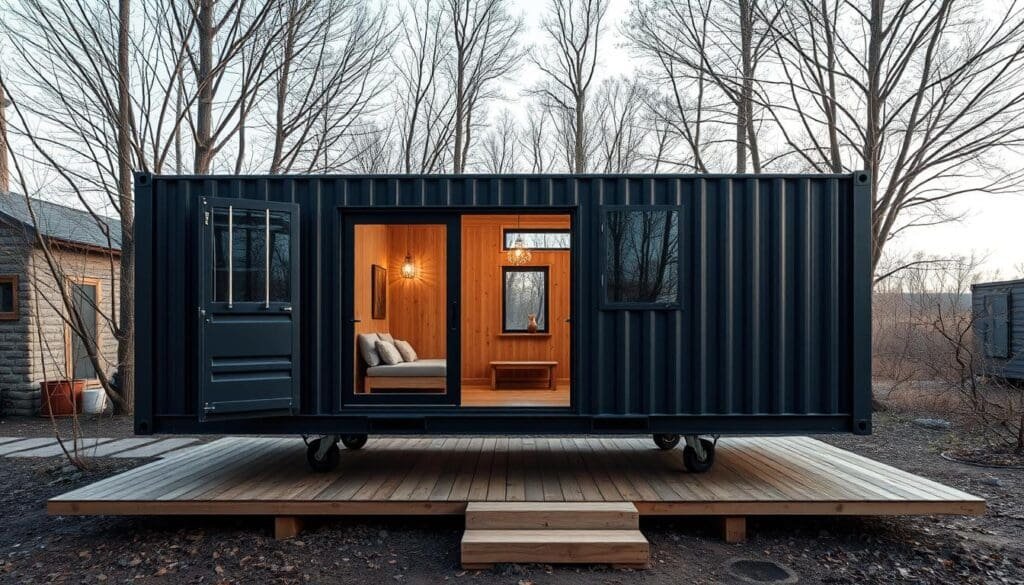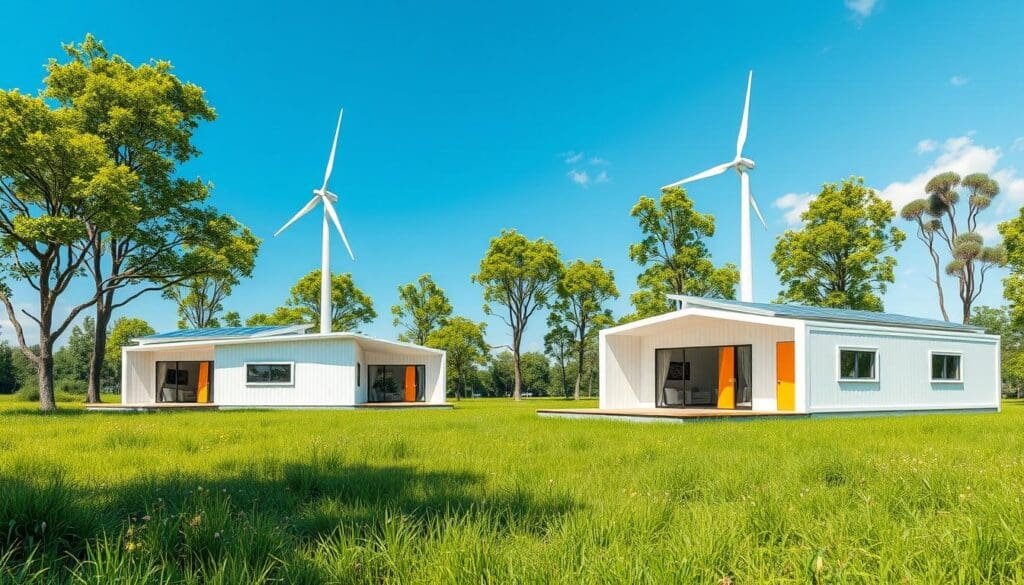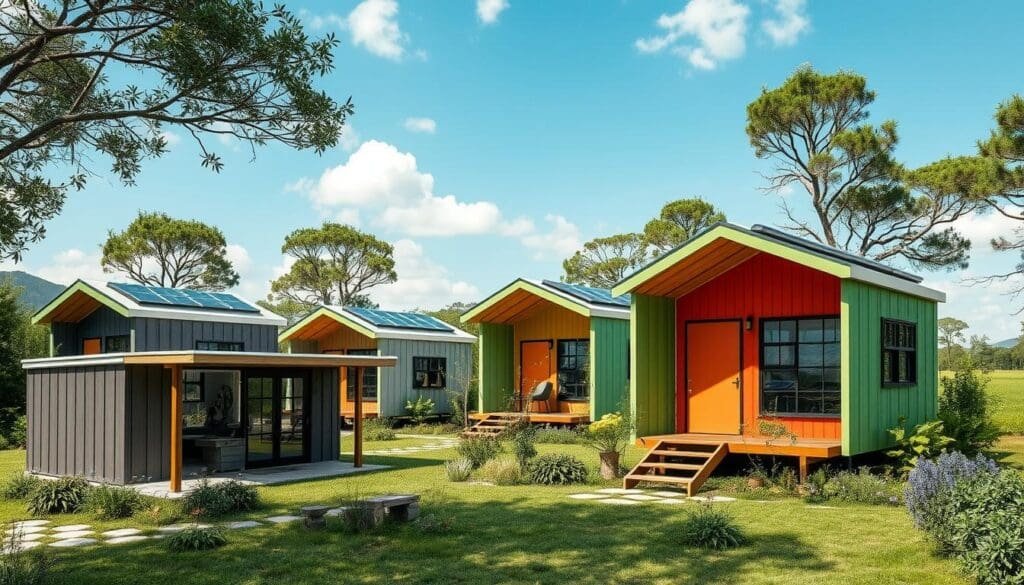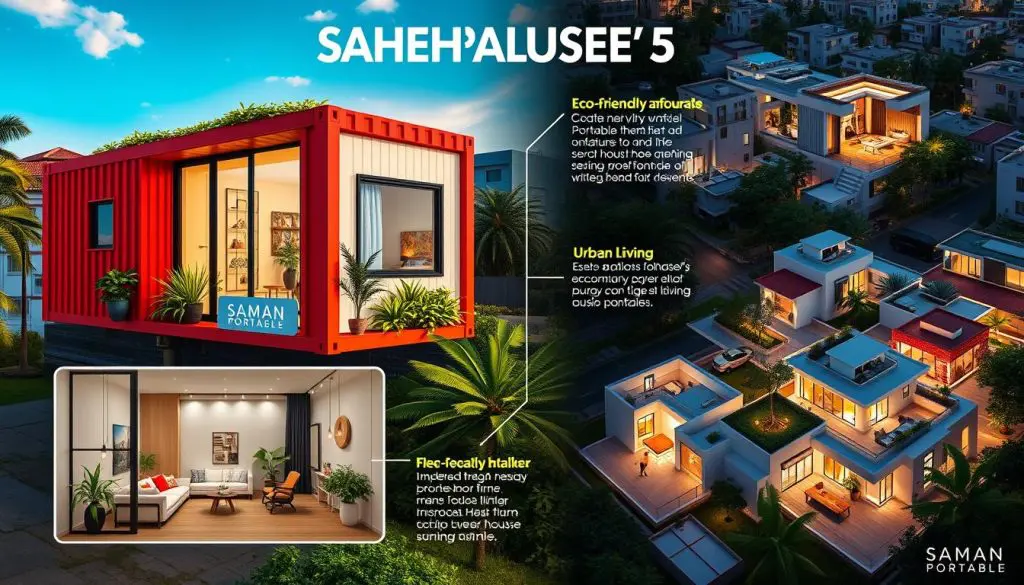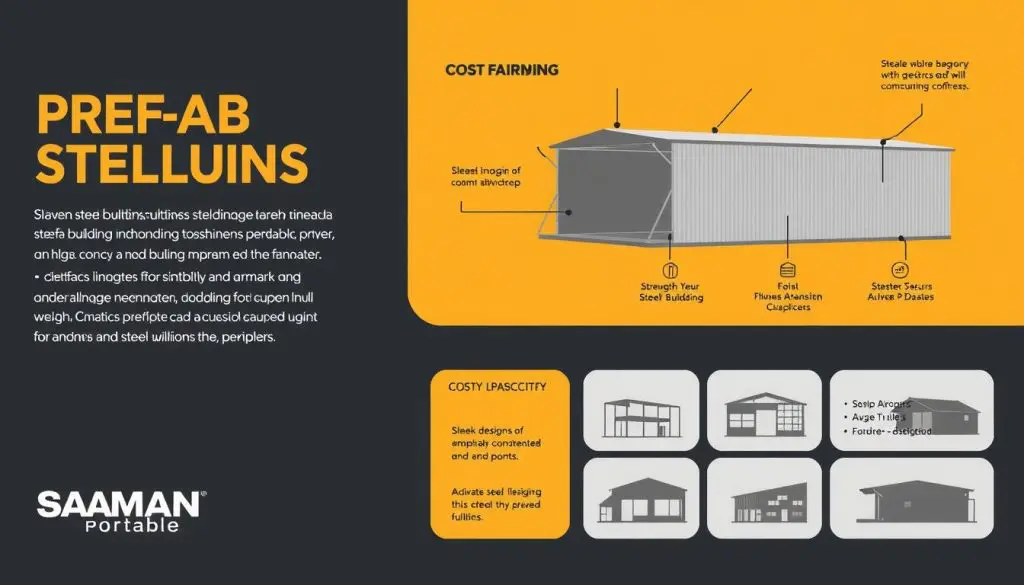Container House Interior Design: Ideas for Modern Spaces
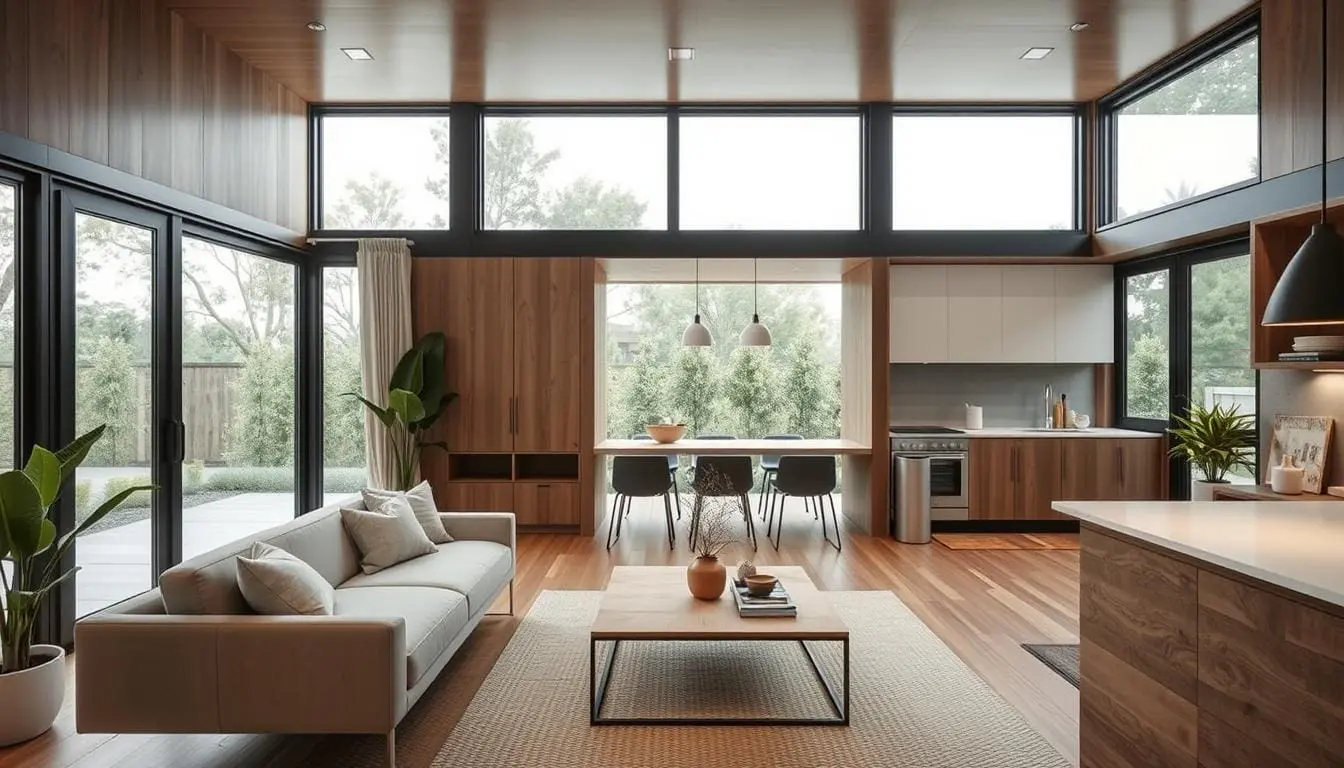
Container homes are changing the way we live, offering a green and affordable way to house ourselves. Made from old shipping containers, these homes are becoming popular everywhere. They are not just homes; they are spaces that can be made to look however you want, from cozy to modern.
Explore our wide range of portable cabin solutions to find innovative designs and ideas for container homes.
These homes can be used for many things, like where you live, a place for guests, an office, or even a spot for fun. They are flexible and can be made to fit your needs perfectly.
Key Takeaways
- Container homes provide sustainable and cost-effective living solutions
- These innovative spaces can be customized to various interior design styles
- Container houses offer flexible and functional living options for diverse purposes
- Repurposed shipping containers are transforming the housing landscape
- Container home interiors can feature creative and modern design elements
Understanding Container Home Basics
Container homes are becoming more popular as a unique way to live. They use old shipping containers, with over 50 million in the U.S. These homes are strong, weather-resistant, and can handle extreme conditions.
What Makes Container Homes Unique
Shipping containers are made to carry goods worldwide. They are very sturdy and can last a long time. This makes them great for building homes that are durable and long-lasting.
Their steel construction and watertight design also protect against weather. This makes them a solid choice for homes.
Types of Shipping Containers for Housing
The most common sizes for housing are 20-foot and 40-foot containers. The 40-foot ones offer about 320 square feet of space. They have 9.5-foot ceilings, perfect for one to two bedrooms, a bathroom, and a kitchen/living area.
Legal Requirements and Building Codes
Before starting a container home project, check local laws and building codes. Zoning laws, permits, and regulations differ by area. It’s important to do a site assessment and get the right approvals.
Knowing about container homes helps homeowners and modular home manufacturers make smart choices. They can explore container house building plans and turn their eco-friendly living dreams into reality.
Collaborate with a trusted modular home manufacturer to navigate regulations smoothly and ensure compliance.
Benefits and Challenges of Container Living
Shipping container homes are becoming more popular. They offer both good points and some downsides. One big plus is that they are easy to set up. This makes building them faster than regular houses.
These homes are also very strong and can handle strong winds. They are also good for the environment because they use old steel. But, they might have problems with keeping warm or cool, especially in certain weather.
Getting the right tools for setting up a container home can be expensive. This adds to the cost of the project. Also, getting permission to build one can be hard in some places.
Before deciding on a container home, think about the pros and cons. It’s important to make sure it fits your lifestyle. With the right planning, container homes can be a smart and green choice for housing.
- Affordable and cost-effective construction
- Durable and resilient against natural disasters
- Eco-friendly repurposing of existing materials
- Potential insulation and condensation issues
- Challenges in obtaining building permits
- Need for specialized equipment during installation
Learn more about affordable prefab homes that offer flexibility and sustainability for modern living.
Container House Interior Design: Essential Principles
Designing a container home’s interior involves key principles. Effective space planning, strategic color schemes, and thoughtful lighting choices are crucial. They help turn these small, industrial spaces into cozy, modern homes.
Looking for more inspiration? Discover creative and modern container house interior design tips to transform your space into a stylish haven.
Space Planning Fundamentals
In a container home, maximizing functionality and open flow is key. Designers often choose open floor plans. This combines the kitchen, living, and dining areas, making the space feel larger. Using minimalist furniture and multi-purpose pieces helps use space wisely.
Color Schemes and Material Selection
The colors and materials you choose greatly affect the home’s feel. Warm, natural tones can soften the steel structure’s industrial look. Textures and patterns add interest. Flooring, from hardwood to tiles, affects the space’s look and durability.
Lighting Considerations
Good lighting is vital in container homes. It changes how we see the space and makes it welcoming. Using natural light, like windows and skylights, is key. Adding energy-efficient artificial lighting enhances the space’s function and comfort.
By following these container house interior design principles, you can create modern, efficient, and visually appealing spaces. These are possible in the unique setting of portable cabin solutions.
Explore our comprehensive container house building plans to kickstart your design journey.
Foundation and Structural Requirements
Building a container house requires careful planning of the foundation. The foundation type depends on site conditions, climate, and building plans. It’s wise to consult a structural engineer to ensure the foundation can handle the container’s weight.
Pier foundations are a common choice, using concrete blocks that are 50 cm x 50 cm x 50 cm. For 40-foot containers, two more piers are added to each side for extra support.
Pile foundations involve hammering steel tubes into the ground. This is the priciest option but needed in poor soil or high water areas.
- Slab foundations for a two 40-foot shipping container home would typically be 18 feet wide by 42 feet long.
- Strip foundations, which consist of a concrete strip that is 1-2 feet wide and 4 feet deep, can provide a more cost-effective alternative to slab foundations.
- Strip foundations can be laid around the perimeter of containers or at the top and bottom of the containers.
The soil’s bearing capacity is key, regardless of the foundation type. The USDA Web Soil Survey helps identify soil types. The IRC and IBC provide guidelines for soil capacities. Always apply a safety factor of two to three to ensure stability.
Soil settlement, skin friction, and soil mechanics are also crucial. Working with a structural engineer and following local codes ensures a strong foundation for your container house.
Maximizing Space in Container Homes
Container homes are becoming more popular, and people want to make the most of their space. They use portable cabin solutions and clever furniture to make their homes both cozy and useful. The secret to a great container home is in how you plan your space.
Multi-functional Furniture Solutions
Choosing furniture that does more than one thing can really help. For example, Convertible beds can turn into couches, and dining tables can also be workspaces. These multi-functional furniture solutions help make your home both stylish and practical.
Storage Solutions and Organization
- Built-in cabinets and shelves use up vertical space, giving you lots of storage without taking up too much room.
- Under-bed storage with drawers or rolling containers makes the most of unused space and keeps things tidy.
- Barn doors and sliding partitions save floor space, unlike regular swinging doors.
Vertical Space Utilization
Using vertical space is key in container house interior design. Floor-to-ceiling shelving, loft areas, and elevated platforms can make your home seem bigger. They also offer extra space for living or storing things.
Smart Storage Solutions for Container Homes
As the popularity of container homes continues to rise, innovative storage solutions have become essential for maximizing space and enhancing functionality. The unique nature of container living presents challenges, particularly when it comes to effectively utilizing limited square footage. However, with thoughtful Container House Interior Design, these challenges can be transformed into opportunities to create a stylish and organized living environment. By embracing smart storage solutions, homeowners can ensure that their container homes remain both liveable and aesthetically pleasing.
One effective strategy for optimizing storage in a container home is to incorporate multi-functional furniture. Pieces that serve dual purposes, such as a sofa bed or a coffee table with hidden compartments, can significantly reduce clutter and free up valuable floor space. Additionally, utilizing vertical space through wall-mounted shelves, cabinets, and hooks allows for efficient use of height, making the most of every nook and cranny. By selecting furniture that is not only pleasing to the eye but also practical, homeowners can achieve a harmonious balance of style and functionality.
Another aspect of Container House Interior Design is the creative use of underutilized areas for storage. The space beneath beds or seating can be transformed into hidden compartments, providing additional room for items that might otherwise create a mess. Similarly, customizing built-in storage units that seamlessly blend with the overall aesthetic of the home can enhance both the interior design and functionality. Furthermore, the use of clear bins or labeled containers can help maintain organization, ensuring that every item has its place.
Ultimately, the key to effective smart storage solutions in container homes lies in creativity and flexibility. By embracing innovative design techniques and leveraging available resources, homeowners can craft a living space that not only meets their storage needs but also reflects their personal style. As the trend of container living grows, so too does the opportunity to experiment with Container House Interior Design, creating uniquely functional and visually appealing homes that prioritize both comfort and practicality.
By using these ideas, homeowners can make the most of their container house interior design. They can create a cozy, organized, and efficient home inside a shipping container.
Modern Kitchen Design for Container Homes
The kitchen is key in container house interior design. It must be both functional and stylish. In container homes, every inch matters, so the kitchen design needs careful planning.
One smart move is to make cabinets go all the way up to the ceiling. This uses vertical space well. Glass-front cabinets add an airy feel, fitting the container home’s modular style. Mixing stainless steel appliances with wood or stone keeps the look modern and warm.
Using space-saving furniture, like a kitchen island with seats, is smart. It makes the most of small spaces. Changing the layout of the island or sink can also improve the kitchen’s flow.
The modular home cost is influenced by the kitchen design. Choosing affordable, yet quality, materials and appliances is key. Brands like Home Depot offer good options without spending too much.
Creating a great kitchen in a container home is about finding the right balance. It’s about being creative, using space wisely, and staying within budget. This way, homeowners can enjoy a kitchen that’s both beautiful and practical.
Creating Comfortable Living Spaces
Designing cozy living areas in container homes needs careful planning and creative ideas. From the living room to the bedroom, it’s all about smart layouts and designs that do more than one thing. This way, even with less space, you can still have a warm and welcoming home.
Living Room Layout Options
In the living room, aim for a layout that’s both flexible and inviting. Choose furniture that can change its use, like sofa beds or ottomans with storage. Place the seating to encourage talking and moving around, keeping the room open and free.
Bedroom Design Strategies
Bedrooms in container house interior designs should be both useful and comfy. Use vertical space for storage, like built-in shelves or wall units, to keep the floor clear. Pick a affordable prefab homes bed and mattress that fit well without taking over the room.
Multi-purpose Areas
- Versatile spaces, like home offices, guest rooms, or play areas, are super useful in container homes.
- Use sliding doors, partitions, or furniture that can change to meet different needs.
- Make sure to add lots of storage and organization to keep things neat and tidy, even in busy areas.
By carefully planning living spaces, bedroom layouts, and areas that do more than one thing, container homes can offer a cozy and practical living space. They make the most of every inch of space.
Bathroom Solutions for Container Houses
Creating bathrooms in container house interior design needs creativity and smart space use. Use compact fixtures, wall-mounted toilets, and corner sinks to save space. Glass shower enclosures make the area feel bigger.
Good air flow is key to avoid moisture problems in modular home manufacturers homes.
Use vertical space with tall shelves, lofted beds, and storage to free up floor space. Multi-functional furniture, like sofa beds and fold-out tables, saves space and boosts functionality.
- Big windows and glass doors bring in lots of natural light, making the space feel bigger and welcoming.
- Layered lighting with overhead, task, and accent lights improves the home’s feel.
- Choose light colors for walls and ceilings, like white, beige, and gray, to make the space feel airy.
Adding natural materials like wood, bamboo, and stone warms up the container house interior design. Built-in storage, under-furniture storage, and wall-mounted solutions help use space well.
For bathroom design, pick space-saving fixtures like corner sinks, wall-mounted toilets, and small bathtubs or showers. This smart use of space boosts both function and comfort in modular home manufacturers homes.
Natural Light and Ventilation Strategies
When designing a container home, natural light and ventilation are key. Placing windows on the south side lets in lots of sunlight. This makes the home bright and welcoming. Skylights in non-stacked homes also help, cutting down on the need for artificial lights.
Designers use cross-ventilation to improve air flow. This means placing windows on opposite sides or using wing walls. It helps keep the home cool without using a lot of energy.
Window Placement
Where you put windows in a container house interior design matters a lot. Windows facing south get the most sunlight. This means less need for heaters in cold weather.
Skylight Integration
Adding skylights to the roof of a container house building plans boosts natural light. They make the space feel bigger and open. Plus, they save energy by reducing the need for artificial lights.
Cross-ventilation Techniques
- Positioning windows on opposite walls to create a natural airflow
- Utilizing wing walls to direct the flow of air through the living spaces
- Incorporating operable windows and doors to allow for cross-ventilation
By carefully planning natural light and ventilation, container homes become cozy and energy-smart. They perfectly mix style and practicality.
Incorporating Biophilic Design into Container Homes
In recent years, the trend of container homes has surged in popularity, offering an appealing blend of affordability, sustainability, and versatility. However, to truly elevate these unique living spaces, incorporating biophilic design principles can enhance the overall experience of living in a container house. Biophilic design emphasizes the connection between humans and nature, promoting well-being and comfort through natural elements. By integrating these principles into container house interior design, homeowners can create a soothing and inviting environment that fosters tranquility and inspiration.
One effective way to achieve biophilic design in container homes is by maximizing natural light and ventilation. Large windows, skylights, and open layouts can create a sense of spaciousness while allowing sunlight to flood the interiors. This approach not only reduces reliance on artificial lighting but also enhances the mood of the space. Additionally, using materials that mimic natural elements, such as wood or stone finishes, can help create a warm, organic feel that resonates with the outdoors. The incorporation of potted plants and green walls can further bridge the gap between indoor and outdoor spaces, introducing vibrant colors and enhancing air quality.
Soundscape also plays a crucial role in biophilic design, especially in the context of container homes, which can sometimes feel confined or isolated. Strategically placing water features or integrating natural sound elements, like wind chimes or bamboo, can create a calming auditory environment that promotes relaxation. Moreover, the use of soft textiles and furnishings inspired by nature can complement these features, fostering a harmonious and cohesive aesthetic throughout the container house.
Ultimately, the goal of incorporating biophilic design into container house interior design is to create a peaceful sanctuary that nurtures both the mind and body. By thoughtfully blending nature-inspired elements with the innovative architectural features of container homes, residents can enjoy a unique space that is not only functional but also deeply connected to the beauty of the natural world. As more individuals embrace this design philosophy, the potential for sustainable living continues to expand, reshaping the way we think about our built environments.
Insulation and Climate Control
Insulation is key in container house interior design. It keeps temperatures comfortable and stops moisture buildup in affordable prefab homes. Homeowners have many insulation choices, each with its own benefits and things to think about.
Spray foam insulation is a top pick. It has an R-value of up to 18 and seals gaps well. It’s great for places that need to stay at a certain temperature, like server rooms. Rigid foam insulation, in panels, also keeps temperatures steady and is strong.
- Spray foam insulation: R-value of 6 (1-inch), 12 (2-inch), or 18 (3-inch), ideal for temperature-sensitive enclosures
- Rigid foam insulation: High thermal resistance and structural integrity, available in panels
- Blanket insulation (Batt and Roll): Relatively inexpensive and easy to install, made from fiberglass, mineral wool, or natural fibers
- Insulating panels: Provide high thermal resistance and structural integrity for walls, roofs, and floors
Keeping the climate right is also important for comfort in container house interior design. Using energy-saving HVAC systems that fit the small space helps control temperature and humidity. Adding passive solar design, like smart window placement and thermal mass materials, can also cut down on heating and cooling needs.
Thinking about insulation and climate control carefully helps make living spaces in containers comfortable and efficient. These homes meet the special needs of affordable prefab homes in a smart way.
Sustainable Design Features
Container homes are great for living sustainably. They use eco-friendly materials, save energy, and conserve water. This makes them good for the planet.
Eco-friendly Materials
Container homes can use recycled and reclaimed materials. This includes repurposed wood and salvaged steel. These materials make the home more eco-friendly.
Energy-efficient Solutions
- Solar panels use the sun’s energy, cutting down on power bills.
- LED lights and energy-saving appliances help save energy.
- Good insulation keeps the home warm or cool without using too much energy.
Water Conservation Systems
- Rainwater harvesting collects rain for household use, saving water.
- Greywater recycling uses water from sinks and showers again.
- Using less water in plumbing and appliances helps too.
Container homes with sustainable features offer a green lifestyle. They’re also cost-effective and space-saving.
Future Trends in Container Home Interior Design
As sustainable living continues to gain traction, container homes are emerging as a popular choice for those seeking an eco-friendly lifestyle. The versatility of these structures allows for innovative and creative interior designs that can redefine living spaces. Future trends will likely focus on maximizing functionality while maintaining aesthetic appeal. One notable trend is the use of modular furniture that adapts to the changing needs of residents, providing multi-functional spaces without sacrificing comfort. Compact designs that incorporate built-in storage solutions will also become essential, as homeowners look to minimize clutter in smaller areas.
Natural materials and biophilic design elements are expected to play a significant role in the interior design of container homes. Incorporating wood, stone, and plants not only adds warmth and character to the space but also enhances the overall well-being of occupants. Additionally, large windows and open layouts will promote air circulation and natural light, creating an inviting atmosphere that makes even the smallest container feel spacious. Expect to see an increase in the use of innovative lighting solutions, such as smart LED systems that can be adjusted to suit different moods and activities throughout the day.
Another trend to watch is the rise of DIY container home renovations, where homeowners take an active role in crafting their living spaces. This movement is thriving in online communities where enthusiasts share tips, guides, and inspiration to transform an ordinary shipping container into a dream home. In this context, building a site office using a container has gained popularity, with individuals looking to set up functional workspaces at home. The site office container price is generally more affordable than traditional office structures, making it an attractive option for small business owners and freelancers looking to create a dedicated work environment.
As the popularity of container homes expands, so too will the accessibility of design materials and resources. Upcycling and repurposing existing materials to contribute to unique interiors will likely become a staple in design sensibilities. With a growing emphasis on community and sustainability, container homes will not only serve as residences but also as pioneers in the architectural landscape, influencing future trends in eco-conscious living. The future of container home interior design is poised to be a blend of innovation, efficiency, and decorative flair, reflecting the values of a new generation of homeowners.
Exterior Integration and Outdoor Living
Container homes can be a great way to improve your living space. They offer a chance to mix indoor and outdoor areas well. This makes your home feel more open and connected.
Using the right exterior cladding or paint can help your container home fit in or stand out. Adding gardens or trees can also make it look more natural and welcoming.
- Add decks, patios, or rooftop gardens to extend the living area and create an outdoor oasis.
- Incorporate sustainable and eco-friendly materials for the exterior finishes, aligning with the overall design philosophy.
- Strategically place windows and doors to maximize natural light and ventilation, blurring the lines between indoor and outdoor spaces.
By carefully blending your container home with its surroundings, you can make your living space better. You’ll get a home that feels connected to nature and is good for the planet.
Cost Considerations and Budgeting
Cost is key when thinking about container homes. They can be affordable, but you need a good budget. The price depends on the container size, needed changes, interior details, and getting the site ready.
The starting price for a shipping container is $2,000 to $5,000. Adding doors and windows can cost $1,500 to $3,000. Insulation, which keeps energy in, costs $800 to $3,000, based on the materials.
Adding things like electricity, plumbing, and heating costs $3,000 to $5,000. Other costs include moving the container and following local building rules.
Even with these costs, container homes can save money. They build faster and you can do some work yourself. With smart planning, you can make a cozy and useful home that’s within your budget.
There are tools to help with budgeting, like planners and lists for DIY projects. The eBook about container home living also gives financial tips. With the right planning, container homes can be a smart and creative way to live.
For a detailed modular home cost breakdown, check out our guide to understand the investment and savings opportunities.
Cost vs. Value Analysis of Container Homes
In recent years, the popularity of container homes has surged, prompting a growing interest in the cost versus value analysis of this innovative housing solution. Container homes are constructed from repurposed shipping containers, offering a sustainable alternative to traditional building methods. The initial appeal lies in their affordability; the cost of purchasing and retrofitting a shipping container can be significantly lower than that of conventional building materials. However, the true value of container homes extends beyond mere financial considerations, encompassing factors such as durability, flexibility in design, and environmental impact.
When evaluating the cost of container homes, it’s essential to consider both upfront expenses and long-term savings. While the initial investment might be lower, additional costs may arise from insulation, plumbing, electrical work, and unique container house interior design elements to create comfortable living spaces. These factors can vary significantly based on the intended use of the home—whether it’s a primary residence, vacation retreat, or a rental property. Therefore, potential homeowners must weigh the benefits of a customized interior against the financial implications of renovations and modifications, ultimately deciding if it aligns with their budget and lifestyle.
The value proposition of container homes also hinges on their unique architectural appeal and customization potential. With innovations in container house interior design, homeowners are increasingly turning these industrial structures into stunningly stylish spaces. The flexibility in layout and size allows for creativity, enabling individuals to create functional and beautiful living environments tailored to their needs. Furthermore, the environmentally friendly aspect of utilizing recycled materials can enhance its value in the eyes of eco-conscious consumers, making container homes not just a housing alternative, but a statement of sustainability.
In conclusion, the cost versus value analysis of container homes is multifaceted, encompassing financial, aesthetic, and environmental factors. While initial costs may attract potential buyers, the true value lies in the long-term benefits of customization, durability, and sustainability. As more people seek affordable and innovative housing solutions, container homes present a compelling case, proving that cost-effective living can coexist with stylish, modern design.
If you’re curious about detailed site office container prices, explore our guide for a breakdown of costs and factors influencing pricing.
Conclusion
Container house interiors offer a chance to create modern, green, and affordable homes. They solve the challenges of living in a small space, like making the most of every inch. They also meet legal needs, making them a great choice for city living or those wanting a green home.
The trend of container house interior design is on the rise. These homes are not just practical but also stylish. With smart furniture and color choices, they can be both cozy and chic, despite their small size.
Container homes also focus on being eco-friendly. They use recycled materials and save energy. As affordable prefab homes, they show that you can have style, function, and care for the planet all at once.
To learn more about our mission, vision, and dedication to providing innovative modular solutions, visit the official page About SAMAN Portable. Explore how we’re shaping the future of sustainable living and workspace solutions.
FAQ
What makes container homes unique?
Container homes are special because they use old shipping containers. These containers are strong, weatherproof, and can handle harsh conditions. You can make them look any way you want and use them for many things, like homes, offices, or even guest houses.
What types of shipping containers can be used for housing?
You can use different sizes of containers for homes, like 20-foot or 40-foot ones. The size you pick depends on what you need for your home.
What are the legal considerations for building a container home?
When building a container home, you need to think about laws, building codes, and getting the right permits. Always check with local officials and do a site check before starting to make sure you follow all rules.
What are the benefits and challenges of living in a container home?
Living in a container home has many good points. They are easy to set up, need simple foundations, and are good for the planet. They’re also very strong and can handle strong winds. But, they might need extra work for insulation and can get damp in some places. Getting permits can also be hard in some places.
How can interior design optimize space in a container home?
To make the most of a container home’s space, plan well, choose colors wisely, and pick materials carefully. Use furniture that does more than one thing, find smart ways to store things, and use the walls to save space.
What are the key considerations for foundation design in container homes?
When designing the foundation for a container home, think about the site, weather, and how the home will look. You need to consider water pressure, frost, and pests. It’s best to talk to a structural engineer to make sure the foundation is right.
How can container homes be designed for sustainable living?
Container homes are great for living green. You can use eco-friendly materials, add solar panels and LED lights, and save water. These steps help make your home more eco-friendly.
What are the typical cost considerations for building a container home?
Building a container home can be affordable, but you need to plan your budget well. Prices change based on the container size, what changes you make, the inside look, and the site. You might also pay for moving the container, renting a crane, and hooking up utilities. But, it’s often cheaper than building a regular house and takes less time.
 Container Cafe
Container Cafe
















































































